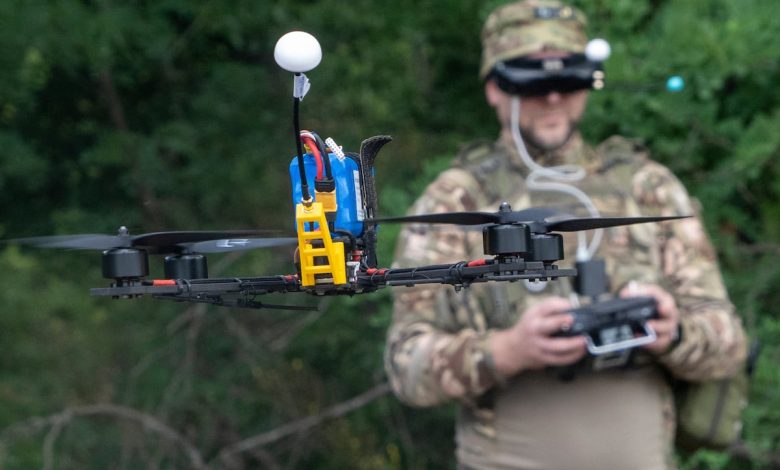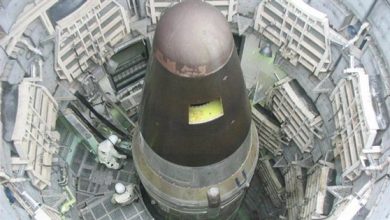Of fiber-optics and FPVs – 6 questions with a Ukrainian drone trainer

MILAN — The “Typhoon” unit is a special forces unit within Ukraine’s National Guard that focuses exclusively on unmanned systems and all aspects related to the technology. Established in 2024, it initially specialized in frontline first-person-view operations but has since expanded its capabilities to other types of unmanned aerial systems.
Its primary tasks include developing and enhancing drone capabilities in combat operations, as well as providing effective training to operators. It achieves this, in part, by integrating engineers into the team, who help to rapidly modify drones, and capable pilots who carry out complex sorties.
In a video interview with Defense News, one of its members, who goes by the callsign “Alex” for security reasons and works as an analyst providing training support to drone pilots, discussed how the unit is tackling operator shortages, adapting to intense electronic jamming and countermeasures, and the effectiveness of domestic and Western-supplied unmanned systems against Russian platforms.
Has your unit been affected by a lack of pilots or operators? How are you addressing this challenge?
I would say yes. There is a shortage of pilots, but even more so, a shortage of motivated individuals. Right now, it’s harder to train a pilot from scratch, especially if they don’t have any experience with radios, engineering or related technical fields. In general, it takes at least three months to train the pilots from scratch to the beginner level.
When we talk about pilots, it’s worth mentioning that they also need to be a bit like engineers – if we talk about FPV drones. When you are in position, you have to understand how the system works. If something goes wrong, you should be able to repair it; if the drone crashes, you need to figure out how to make it fly again. So piloting skills are important, but it’s equally important to have some engineering knowledge as well.
How to address this issue is a complex question. The first thing is quality over quantity. We do our best to train people and provide them with fresh knowledge and analysis of what’s happening on the battlefield. For example, when we talk about FPVs, we discuss what the best current setups look like and what components are needed.
Let’s say I receive new information about Russian jamming systems on the battlefield — details about the different frequencies they cover. I analyze that data, try to find the gaps, and share this with our pilots. We communicate which radio and video frequencies can still be used effectively for successful missions.
This type of information sharing is key because it improves both the quality of our pilots and the drones they operate, making us more effective. Maybe we have fewer pilots, but they’re better trained and better prepared.
For instance, in communications, a pilot might start a flight and lose control after 10 minutes. We try to understand why that happened — what caused the problem. We review the frequency data, the drone’s altitude at the time, the drone’s route, and collect this information over longer periods to identify patterns and understand the dynamics of how things are changing.
What are some of the current biggest challenges you face when it comes to electronic warfare? What works best as a jamming system?
The biggest challenge is the ability to get information about things on the battlefield today, while also being able to predict a little bit what will be going on tomorrow. Because yes, many Russian systems can now cover almost all the frequency spectrum, so we always have to be attentive to their functioning, but know these can’t work all day and night. On the battlefield, there are often shortages of power and people.
Generally, first [each side] will try to analyze who is flying the mission, and after this they will switch on the jamming systems, for instance. Here is where effectiveness comes in. Because if you are skilled enough, you can strike a target in one shot, without having them [Russian forces] have time to switch on their jamming systems. However, if you can’t reach the target in a single shot, the jamming systems will have time to switch on, and it will be quite hard to destroy it.
Some FPVs now use multiple receivers with antennas in different polarizations to overcome jamming systems. This redundancy works well because if one receiver or frequency is jammed, the drone can maintain control through the alternate receivers. For example, using two or three different receivers on separate frequencies, combined with antennas in different polarizations (linear, circular), significantly increases the chances of maintaining a stable connection even in heavy EW environments.
What are the most pressing requirements when it comes to unmanned technologies?
Many pilots and engineers use the same Chinese spare parts, especially for FPVs, and just mix how they can utilize a couple of them.
Here, again, I think quality is more important than quantity — having additional spare parts is crucial. For example, if you have different video transmitters for different frequency ranges (say 3GHz, 1.2Ghz, 6+Ghz and so on), you can change these parts as fast as possible to make you more successful.
Even if you are successful on the frontline today, the Russians will analyze the situation and may deploy jamming systems for those frequencies tomorrow, and then you lose if you don’t have spare parts for other frequencies.
The same applies to radio control: The faster you can swap components, the more successful you become. There have been many attempts to increase the localization of the production of spare parts on the Ukrainian market, which has worked to a certain extent.
What observations have you made regarding the effectiveness and performance of Western-made or Western-provided unmanned technologies?
Some of the most successful Western systems we’ve seen are in the fixed-wing reconnaissance drones category. Some of the most effective ones have included the German-made Vector drones and Polish-made FlyEye drones. What has made them successful is that they have direct feedback on the ground, ones who operate their drones. They get fast feedback from these units, are able to quickly modify the systems, and send them back. These companies are also localized in Ukraine.
Unsuccessful ones, for example, if we talk about FPVs or other smaller recon drones, in most cases, they are not the best quality when it comes to current battlefield conditions and being able to perform in the EW environment we are faced with on the frontline.
There are also information gaps between many European or U.S. manufacturers about what is going on the battlefield right now and when this information is made available or reaches them. This is also true for some Ukrainian producers that do not have direct contact with ground units.
Last year, I met with a European manufacturer of a fixed-wing strike drone, and everything looked interesting and reliable until we asked whether they had tested it in similar jamming conditions as seen on the battlefield. The producer said, “No, we haven’t even once,” — then, it’s a question of not knowing how such a system will behave on the battlefield.
Another example of a system not working very well is from the U.S. company Skydio; some of their drones have not been reliable under current jamming conditions found on the front.
These realities also apply to some Ukrainian manufacturers and domestically produced systems. During recent unmanned ground vehicle testing, several platforms encountered significant challenges under conditions designed to replicate actual battlefield scenarios.
The testing protocols were deliberately strict: vehicles had to reach firing positions and engage targets from distances between 300 and 500 meters. Crucially, the manufacturers themselves had to operate their own robots from a dugout — without direct line of sight or stable communications — relying only on the robot’s onboard camera feed and a surveillance drone overhead.
This approach was intentional, to put developers in the shoes of actual soldiers. It made the task considerably harder because the drones weren’t being piloted by experienced operators. If a UGV stopped, crossed boundary markers, or became stuck in the terrain, that run was terminated. Manufacturers were prohibited from recovering their stuck vehicles — these became additional obstacles for subsequent robots starting their runs.
Before deployment, participants could only review quadcopter flyover footage, just as they would in real combat conditions. They couldn’t walk the terrain or conduct ground reconnaissance — you can only use recon drones to understand what lies ahead, and must adapt on the spot.
This testing revealed a critical gap: many systems perform well in controlled environments where developers understand the terrain intimately, but struggle when operators must rely solely on remote sensing and make real-time decisions without ground truth. It’s a sobering reminder that battlefield effectiveness requires more than just technical specifications. It demands systems designed for operation under severe informational constraints.
Based on the targets you are intercepting or having to defend against, have you noticed any changes in the quality or components of Russian unmanned systems?
Currently, there are many cases of fixed-wing reconnaissance drones carrying FPVs and releasing them over target areas of interest. These setups can reach 30 to 50 kilometers before dropping the FPV, which has proven to be an effective tactic. In this role, the fixed-wing drone serves not just as a carrier, but also as a reconnaissance platform and [relay], providing significantly stronger connectivity to the FPV drone and helping to overcome the majority of jamming systems on the frontline.
The Russians have also been working on the quality of the fiber-optic drones they use, around the distances they can reach.
Previously, they could spread 15-20 km; now, sometimes this is 25-30km. An example of this was that they were able to strike Kramatorsk with a fiber-optic drone strike, which was one of the first times they were able to hit a major city from far behind frontlines with these platforms.
For us, the most critical part is how reliable fiber-optic drones are. On both sides, these drones have had a lot of interruptions in their signal. For now, the main change we are focused on is how to create the spool fiber for these drones that will be reliable, should we use more lubricants, or should we look at the diameter of the fiber-optic. The devil is in the details.
What are the efficiency rates of using FPV drones versus fiber-optic ones on the battlefield?
This is a complicated question: it really depends on the skills of the pilots. For example, how many spare parts do you have available to make some additional improvements to your drone? When we talk about the most successful (FPV) pilots, I would say the success rate of their missions is approximately 70% to 80% – but it really depends on how skillful the pilot is.
For mid-range skilled pilots, I would put this at a 40-50% success rate, but for new operators, it sometimes looks like a disaster, and that rate can drop to 20%.
When it comes to fiber-optic drones, it is a really different situation – I would say it’s like maybe 40-50% of success rates is the best you can achieve because a lot of additional things should be accounted for. For fiber-optic drones, you have to change your piloting approach. For these drones, success also depends on artillery intensity (which can sever the cable), weather and wind conditions, the density of friendly FPV operations that might accidentally cut the fiber-optic line, and careful route planning to avoid roads, power lines, and other obstacles that could damage the cable.
Elisabeth Gosselin-Malo is a Europe correspondent for Defense News. She covers a wide range of topics related to military procurement and international security, and specializes in reporting on the aviation sector. She is based in Milan, Italy.







